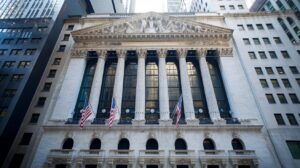A Bold Prediction from Bank of America’s CEO
Bank of America’s CEO, Brian Moynihan, has shared his prediction that the Federal Reserve will hold off on cutting interest rates in the near future. This prediction comes at a time when the U.S. economy is still dealing with inflationary pressures and ongoing consumer demand. It’s essential to understand why this outlook matters and how it could impact your financial planning, whether you’re an investor, consumer, or business owner.
The Economic Landscape: Why the Fed Will Hold Rates Steady
To better understand Moynihan’s perspective, we need to break down the current economic landscape. Over the last few months, consumer spending has seen a steady increase, growing by 6% in the early months of 2025 compared to the same time in 2024. This surge in consumer spending indicates that the economy is not in a state of recession, which would usually trigger a rate cut by the Fed.
However, inflation remains a significant concern, and the Federal Reserve is known for its cautious approach to managing the economy. If rates were cut too quickly, inflation could rise again, undermining the purchasing power of consumers. By keeping rates steady, the Fed is providing a stable environment for long-term economic planning while trying to prevent further inflation.
| Key Economic Indicators | Early 2025 | Early 2024 | Growth (%) |
|---|---|---|---|
| Consumer Spending | 6% increase | 3% increase | 6% |
| Retail Sales | Positive growth | Positive growth | 5% |
| Inflation Rate | 3.2% | 3.4% | – |
| Unemployment Rate | 3.9% | 4.1% | – |
This table provides a snapshot of key economic indicators that have contributed to the decision to keep rates steady. While inflation has slightly decreased, the overall stability of the economy suggests that drastic changes in interest rates may not be necessary right now.
Why This Prediction Matters for Consumers and Businesses
Moynihan’s prediction directly impacts both consumers and businesses. For consumers, it means that borrowing costs, such as mortgage and car loan rates, will likely remain at their current levels. This steadiness offers predictability, which is crucial for financial planning.
For businesses, particularly those relying on credit, the current environment could mean more stability. However, they should also remain cautious about future rate hikes if inflation resurges. Understanding these dynamics can help both individuals and businesses plan their financial strategies in the short and long term.
The Federal Reserve’s Decision-Making Process: A Tightrope Walk
The Federal Reserve’s decisions on interest rates are always a balancing act. On one hand, they must ensure that inflation remains under control; on the other, they want to avoid hindering economic growth by raising rates too quickly. Understanding this balance is crucial to predicting the Fed’s next moves.
In this case, the Fed’s approach is one of cautious optimism, with a preference for monitoring economic data before making a move. This wait-and-see approach allows the economy to adjust and gives the Fed time to evaluate whether any further rate changes are needed.
Conclusion: What’s Next for the U.S. Economy?
While Brian Moynihan’s prediction may provide some clarity, the U.S. economy remains in a state of flux. Key variables like inflation, consumer behavior, and global economic conditions will continue to shape the Federal Reserve’s decisions. As consumers and businesses, staying informed about these shifts will help guide your financial decisions and keep you prepared for potential changes in interest rates.
This is why it’s crucial to track key economic indicators regularly and adjust your financial strategy accordingly. Whether you’re managing a business or planning your personal finances, being proactive in understanding the economic climate can help you navigate potential challenges effectively.
- Consumer Confidence: In early 2025, consumer confidence reached its highest point in three years, which directly correlates with increased spending. This provides further evidence that economic conditions are favorable for maintaining interest rates.
- Housing Market Trends: Despite higher borrowing costs, the U.S. housing market remains stable. This suggests that consumers are confident enough to invest in real estate, even with higher mortgage rates.





